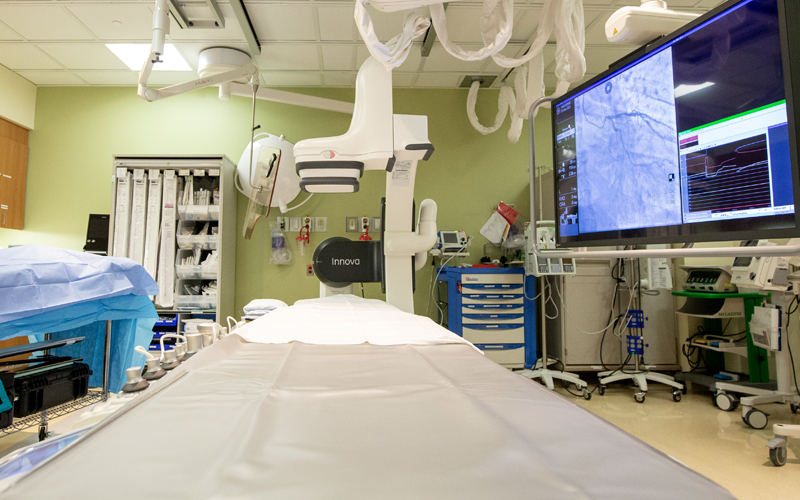
Women often put everyone else first, sometimes at the risk of ignoring their own health. But when it comes to matters of the heart, women should seek care whenever they sense even the slightest bit of trouble.
Today, many common heart conditions are treated inside a cardiac catheterization lab. It’s a high-tech space with X-ray machines, monitors, workstations and—most importantly—talented doctors, nurses and technologists. Let’s explore four ways that the team inside the David M. Flowers Cardiac Catheterization Lab at Grand View Health protects and treats women’s hearts.
- Investigate
The No. 1 reason why you may need care inside a cath lab is to find the root cause of a heart problem. Specially trained doctors, called interventional cardiologists, perform diagnostic catheterizations to explore how well your heart is working and find potential trouble spots.
During the procedure, an interventional cardiologist will insert a catheter through either the wrist or groin and guide up into one or more coronary arteries. “We then use special X-rays, called angiograms, to find any narrowing or blockages,” says Daniel Tsyvine, MD, a double-board certified, fellowship-trained interventional cardiologist with Grand View Health Cardiology Buxmont.
Doctors can also use a diagnostic catheterization to:
- Check the pressure in the four chambers of your heart
- Take blood samples to measure oxygen levels inside your heart
- Examine how well your heart is pumping
- Identify problems with the way your heart’s valves open and close
- Excise heart tissue to perform a biopsy
- Record
A tiny device called a loop recorder helps doctors find the cause of irregular heartbeats (arrythmias) or unexplained fainting that heart monitors can’t detect. Interventional cardiologists implant loop recorders near your heart, just beneath the skin. The recorder collects data and transmits it to your healthcare providers.
“Loop recorder implants are outpatient procedures, which means most patients go home the same day,” says J. Doyle Walton, MD, a triple-board certified, fellowship trained interventional cardiologist with Grand View Health Cardiology Alderfer and Travis. You’ll typically keep the loop recorder implanted until your heart condition is successfully diagnosed.
- Regulate
Two distinct cath lab procedures can help people with irregular heartbeats regulate their rhythm. A pacemaker implant is a small, battery-operated device, inserted just inside the skin. It sends electrical impulses to the heart whenever it detects an irregular or missed beat.
The other procedure, called cardioversion, is an electrical shock delivered through two electrodes placed on the sect and ribs. “Cardioversion resets the rhythm of the heart and is effective in restoring a regular heart rhythm for patients with conditions like Atrial Fibrillation,” says Dr. Tsyvine.
- Restore
Interventional cardiologists deliver emergency care for heart attacks inside a cath lab using a technique called percutaneous coronary intervention (PCI). During the procedure, a doctor threads a catheter through your wrist or groin and up into the blocked portion of a coronary artery.
The catheter includes a deflated balloon at its tip. The doctor inflates the balloon at the site of the blockage, then threads a stent (a tiny mesh tube) through the catheter and places it into the artery to keep it open. “PCI successfully restores blood flow to your heart and saves lives,” says Dr. Walton.
Cath lab care in Bucks and Montgomery Counties
The David M. Flowers Cardiac Catheterization Lab at Grand View Health provides 24/7 emergency heart care and offers scheduled diagnostic and therapeutic cardiac procedures. Our cath lab team helps numerous people throughout Bucks and Montgomery counties survive heart attacks and keep their hearts strong.
Learn more about heart and vascular care at Grand View Health.
